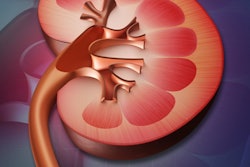
The use of thallium-201 (Tl-201) radiotracer in SPECT imaging has plummeted since 2010, yet its use in nuclear cardiology remains vital for a small but vulnerable group of heart disease patients, according to a group in New York.
Researchers led by Dr. Andrew Einstein, PhD, of Columbia University Irving Medical Center, analyzed public data on the use of thallium (Tl-201) SPECT in Medicare patients between 2010 and 2021. They found the total number of dispensed thallium-201 doses has decreased by 96% (from 1.6 million to 60,823).
"Thallium-201 has retained a modest volume of use and a niche role in nuclear cardiology; its withdrawal from the nuclear cardiology armamentarium will put a small, but vulnerable, patient population at a significant disadvantage," the group wrote. The study was published May 10 in JACC: Cardiovascular Imaging.
Tl-201 was approved in 1979 by the U.S. Food and Drug Administration for diagnosing heart attack on SPECT imaging based on uptake levels of the tracer in heart muscle. Its use has largely been replaced with that of technetium-99m (Tc-99m)-based tracers that emit lower radiation. Moreover, Tl-210 production has been significantly limited in the U.S. since mid-September 2022 and plans for its long-term production are uncertain, according to the authors.
In this study, the researchers examined the temporal trend in the use of Tl-201 for nuclear cardiology diagnostics to address the impact of potential unavailability of the tracer on patient care.
Of note, in 2010, 68% of all SPECT studies used thallium-201, whereas in 2021 that number decreased to 5% of total studies, the authors found. Yet from 2018 onward, its use appears to have plateaued.
"We believe that this largely reflects its remaining use in niche settings in which use of thallium-201 is preferential to that of Tc-99m-based agents," the group wrote.
These niche uses include patients who require heart viability testing prior to coronary revascularization but who are being cared for at centers without access to inpatient cardiac PET imaging, the researchers wrote. In 2021, 10,225 providers conducted SPECT myocardial perfusion imaging, while only 243 and 31 providers conducted PET/CT and PET-only viability studies, they noted.
Second, for some elderly patients and patients with low life expectancy for whom radiation risk is of little concern, the biokinetics of thallium-201 allow earlier imaging after injection, and this significantly decreases testing time and improves the patient experience, they suggested.
Also, some centers have begun using a simultaneous dual-isotope approach for cardiac amyloidosis imaging with Tc-99m radiotracers and low dose Tl-201 to better delineate myocardial boundaries from blood pool, the researchers wrote.
Ultimately, the true use of Tl-201 in the U.S. might be higher than this study estimates, given that the Centers for Medicare and Medicaid Services website data did not include providers who use Tl-201 for SPECT imaging less than 11 times per year, the researchers added.
"In conclusion, thallium-201 has retained a modest volume of use and a niche role in nuclear cardiology," the group stated.





















